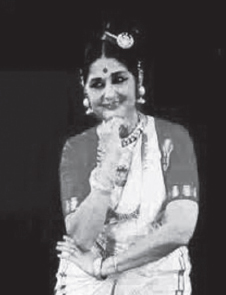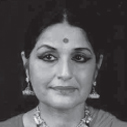Mohini Attam, a lyrical and enchanting dance form, became the sole vehicle for feminine interpretation and developed on the lines of the other classical dance styles of India. It is a solo dance of sheer visual beauty, far removed from the evervigilant supervision of the temple and the grip of rituals. Devotional fervour is permissible but not mandatory. Religio-philosophical tenets are not allowed to interfere with the central idea of dance-its soul-enchantment. The very name expresses its aesthetics (Maha Vishnu appeared as Mohini the enchantress, and danced the dance of enchantment to cast a spell of his maya on the danava-s). The natural beauty of the Kerala landscape provides ample inspiration for its lyrical and lilting movements. Its rounded body kinetics with the distinctive heave of the torso and the soft walk create the sensation of the verdant paddy fields, the undulating palm fronds and the rippling backwaters of Kerala.
Enchantment of the highest order
Mohini is an avatara of Lord Vishnu, the Supreme Sustainer, who takes an avatara to maintain the cosmic order; Vishnu as Mohini (the enchantress) prevents the danavas from becoming immortal during the episode of churning the milky ocean, Ksheerasagara.
The cosmic balance is threatened and so knowledge, the elixir that guides life towards its ideal goal has to be reinstalled. This knowledge, imbued of unbound power is amrita (nectar) that gives immortality, the endless “reality”. Once this knowledge is re-instilled, the cosmic order can be re-established. This was to be achieved by activating the dynamic equilibrium of the opposing spiral forces of the universe.
And so came Vishnu’s mayashakti or vaishnavi-maya in the most bewitching and enchanting female form – Mohini, the enchantress. She danced her dance of enchantment and created an illusion in the minds of the danavas. Mohini personifies the sheer joy and pleasure of living however momentary and “unreal” that life may be. This
lovely illusion intoxicates the beholder by its enchanting beauty.
Mohini Attam is thus the dance that reflects the enchantment that is life, its enjoyment and relish that creates the state of Beautitude. It casts a spell of maya, a mesh net of illusion, on the beholder bathing him in the raga of enchantment, leading him towards knowledge along the path of enchantment, and beauty.
Mohini Attam, a style abounding in beautiful lyrical movements nevertheless, exhibits a conspicuous strength of purpose. The presentation comes out with a deep impact to envelop the spectator in an aura of grace, charm and lyricism with a forceful vivacity. The movements of the body and limbs could be compared to the gently undulating palm fronds filling the Kerala skyline. The gait and stepping are reminiscent of a boat bobbing up and down in the gently soaring backwaters of the Kerala landscape. Though supple and graceful, the palm fronds are not limp, and definitely unlike a clinging creeper. Rather, they have a strong and solid spine attaching them to the trunk of the tree, yet leaving them free to pivot around. And though a boat may bob up and down, yet it is not a wild and uncontrolled movement. The boat is, rather, harmonising with the flow of the stream, in tune with the rhythm and music of nature. And the boat does have the required force and strength which controls this bobbing with the ultimate purpose of reaching its destination to cross over.
The overall impression created by Mohini Attam is shringara which is designed to create enchantment of the highest order that which is caused by the divine influence of Vishnu. Presented in true spirit it must and would shine-out as an epitome of extreme grace, good taste, dignity and above all high cultural values. It is essential to disregard and discard the vulgar absurdities that crept into it.
Nayanabhinaya
The description of Mohini Attam can never be complete without a special reference to that particular group of bodily movements which gives it a distinctive charm of its own. This is what can definitely be termed collectively as nayan abhinaya the movements of eyes, eyelids and eyebrows.
Eyes are supposed to be the mirror of the soul. What one feels is instantly mirrored in the eyes. Before any part of the body can react to a certain mood or emotions it is the eyes which reflect the state of the mind. The widening of eyes in astonishment or horror before the other reactions that follow are the examples of the importance of eyes in the communication of an idea or a mood. And this, mute speech through the eye is not a human prerogative. The liquid eyes of animals speak volumes where speech is denied. In dance also the dancer does not make any use of her speech. Thus her eyes have to be so eloquent as to be able to convey the meaning to the audience. Nature meant eyes to behold and also let others behold. They can prove to be the doors to one’s soul.
Decline and revival
Mohini Attam, which flourished till the end of the 19th century, went into a sad decline. This was the case with all the traditional arts and crafts in India which were under the oppressive rule of the British who set about destroying the Indian identity very systematically. Under this oppressive rule there came to enact some very destructive legislations, one of them being the Anti-Nautch Act which prohibited all sort of dancing in the temples terming the practice as ‘vulgar’. The traditional performers of all the dance traditions gradually lost patronage with the British annexing the local princely states and zamindars who sustained the dance arts. Thus by the first two or three decades the Mohini Attam performers also lost their livelihood and the numbers of gurus as well as performers declined. Between 1966-1967 the writer who had received acclaim for her rendering of Kathakali came on the scene and thereafter started the re-emergence of Mohini Attam as a full- fledged classical dance idiom. In collaboration with the noted Kerala poet-musicologist Shri. Kavalam Narayana Panikkar, Dr. Kanak Rele has created a fully researched parallel repertoire for Mohini Attam which includes the elements of the tenets of the Natyashastra as well as takes into account the long tradition of the Kerala theatrical arts. They have used ‘Sopana Sangeetam’ which is indigenous to Kerala. Sopana Sangeetam is not a system of classical music as the Carnatic and Hindustani are; it is a very specialised way of vocalisation which has roots in the ‘vedocchara’ (vedic chants). It does have some ragas which are not found in other systems but, by and large Carnatic ragas are adapted, to the Sopana mode of singing Kerala abounds in an amazing variety of talas which are also incorporated in this new repertoire. The items thus created and broadly categorised are:
Ganapati – invocation
Ashtapadis – from the Geetagovinda
Padam – nritya or abhinaya items
Pandrari Kattala – nritta or pure dance item
Mukhachalam – nritta item
Slokams – nritya items
Jeeva – nritta item
In all more than 65 such dance pieces created today the almost dying dance art has a rich repertoire which can equal those of more established dance styles.


